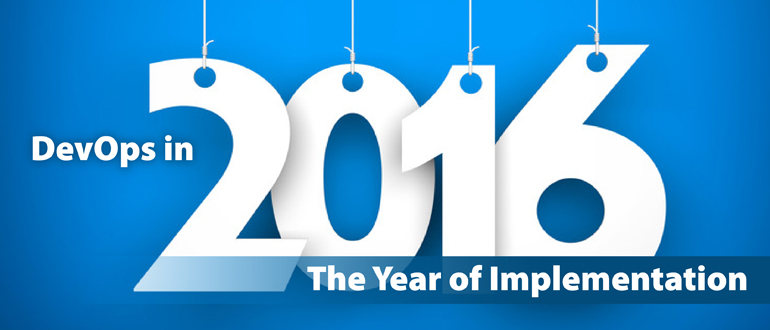
DevOps in 2016: The Year of Implementation

DevOps is the default software delivery approach for modern IT organizations and hyperscale startups that have incorporated the culture into their everyday integration and delivery activities.
However, over the past year, these organizations have also started to recognize and acknowledge that there are challenges in certain aspects of the DevOps approach, including precarious security infrastructures, R&D team member burnout, and the need to close gaps between operations and development with dedicated personnel such as site reliability engineers (SREs).
In 2015, we saw larger enterprises beginning to migrate to Amazon Web Services (AWS) and sketch out their plans to incorporate agile and DevOps methodologies. The implementation process necessitates changing cultural norms, and incorporating new tools and organizational processes. And with DevOps’ great benefits, my prediction is that in 2016, these enterprises will move from the drawing board to implementation.
1. Companies will stop talking and start implementing. In 2016, DevOps culture will finally become mainstream (and not only for startups and tech-savvy companies) as more traditional enterprises jump on the bandwagon and start implementing real DevOps principles. IT leaders will need to figure out how to restructure their teams, adapt DevOps values, concepts and tools, and incorporate continuous integration and continuous delivery practices to do a better job of meeting user expectations of fast and agile delivery.
Having said that, traditional IT organizations that deal with sensitive data and tight change management processes — such as those in the health, finance, and some government sectors — cannot compromise their strict IT delivery standards, especially if they have to comply with security and compliance protocols. Therefore, 2016 will still be just the beginning for enterprise-grade DevOps implementation in several specific industries and verticals
2. SREs will bridge the gap. The growing movement of site reliability engineers (SREs) is being led by Google and has been introduced to the world as part of a practical and more mature DevOps adoption. SREs are software engineers who work in operations and are in charge of availability, change management, emergency response, and monitoring (among other things).
Even early DevOps adopters such as LinkedIn have begun looking for dedicated individuals to fill SRE positions, which require ops as well as code-level management skills. In 2016, we will see an increasing number of discussions on SREs as well as more job opportunities for them, making this new class of engineers key players in DevOps implementation.
3. High demand will mean high salaries. What we have seen within our company as well as among our customers is that dev and ops engineers with strong experience in working with and implementing DevOps are still a rare breed. As more and more IT leaders recognize the need to move to DevOps, the higher the demand and compensation will grow in 2016 for the limited number of experienced engineers.
According to Puppet, DevOps engineers make noticeably higher salaries than most other IT positions and 55% of U.S. DevOps engineers earn $100,000 per year or more. While large IT organizations are building their own education and training plans in anticipation of the move to DevOps, the demand for experienced engineers will still continue to grow in 2016 and beyond.
4. We will have more Big Data benchmarks. Over the past two to three years, the IT industry has embraced Big Data. Technologies such as Hadoop, Spark or MongoDB are commonplace now when it comes to extracting values from large data repositories. Today, companies in industries ranging from Adtech to online gaming to finance are already utilizing Big Data to enhance their core capabilities.
Over the past year, we saw the rise of more solutions that help with implementation and presentation that aid in generating insights and enhancing user experience. Beginning next year, these big data solution vendors will leverage their unique positions and advanced technologies (such as machine learning) as well as their vast amounts of data to create specific industry benchmarks and best practices that will ultimately enhance customer satisfaction.
5. Some companies will reverse-migrate to on-premise. Don’t get me wrong, we’ll still see AWS, Azure, Google Cloud Platform (GCP), and others continue to grow their user bases among next-gen companies as well as traditional organizations such as, the Guardian, which recently failed to build an OpenStack private cloud and consequently decided to go all-in with AWS.
However, companies that have been using the public cloud for the past year or two will see their cloud bills start to soar (if they haven’t already) and look around for cloud solutions that better meet their resource-utilization levels and business model. I think we’ll see more of this so-called “reverse cloud migration” as the cloud business matures in 2016. This is actually a sign that this market is maturing and that people are past the super-hype phase and seeing the pros and cons of the public cloud.
In Summary
Of course, no one can predict the future, but the events of 2015 may hint at what we will see in 2016 — and that points toward an increasing implementation of DevOps practices.
More on the subject:
Some companies will manage to complete their DevOps cycles and have full-blown, continuous deployment straight to production. However, the majority will be challenged by even the basic implementation processes and needs such as which DevOps tools to use, how to reconstruct their organizations, and what state of mind to have.
Still, DevOps will eventually be the norm when it comes to software development and delivery — it is just a matter of time.
Note: This post originally appeared on DevOps.com.
Get started for free
Completely free for 14 days, no strings attached.




